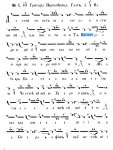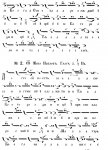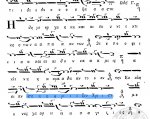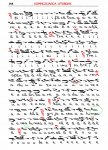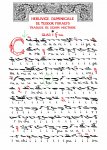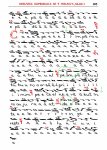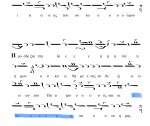You are using an out of date browser. It may not display this or other websites correctly.
You should upgrade or use an alternative browser.
You should upgrade or use an alternative browser.
Formulae in non-Greek Byzantine Music
- Thread starter frephraim
- Start date
Shota
Παλαιό Μέλος
Compare the opening line of Ω του παραδόξου θαύματος you posted to the more modern version I've attached, where the first syllable of θαύματος is on Ke rather than Vou. This is more in line with modern sensibilities and the paradigm of the new sticheraric style. This kind of thing irritated Fr Constantine Papagiannis constantly. I haven't seen his version of Ω του παραδόξου θαύματος, but I would be shocked if he didn't "correct" the classical version so that θαύματος starts on a Ke.
This idea of jumping to KE is not so new. See the Anastasimatarion of Ioannis, the slow heirmos Ὁ μόνος εἰδὼς τῆς τῶν βροτῶν in Mode 1.
Attachments
Shota
Παλαιό Μέλος
I attach Manasii Pop Todorov’s version of the same Axion estin. Fotopoulos’ is perhaps more natural. Points 1) and 2) are the same, at 3) and 4) Pop Todorov does different cadences. He couldn’t retain the Greek ending on high Ni in ἀδιαφθόρως. I also marked with blue one point where he squeezes two syllables instead of one.
Attachments
Yes Fotopoulos does a better setting here. What Pop Teodorov does on lines 8 and 12 seems more modern and less classical, if not a bit clumsy and certainly out of place for the slow heirmologic genre. Composing in the slow heirmologic genre is difficult in any language because most of us are not as fluent in its formulae as we are with those of the new sticheraric and because of its many seeming contradictions/inconsistencies and historical subtleties compared to the more straightforward and consistent logic of the new sticheraric genre. I'm not sure if Pop Teodorov had extensive experience with the slow heirmologic genre, but Fotopoulos certainly seems to have it.
Shota
Παλαιό Μέλος
Composing in the slow heirmologic genre is difficult in any language because most of us are not as fluent in its formulae as we are with those of the new sticheraric and because of its many seeming contradictions/inconsistencies and historical subtleties compared to the more straightforward and consistent logic of the new sticheraric genre.
However if I am starting from a scratch in a language other than Greek, why would I need to retain the accumulated “inconsistencies” and “archaisms” of the Greek original?
Shota
Παλαιό Μέλος
I don’t have Axion estin in Mode 1 (still thinking about some issue), but here is one in Pl. 4. The language is completely different from Slavonic.
There are certain things that require polishing, but the overall structure is correct, I think. I had in mind various Greek Axion estin in classical style (common/synethismenon in Pl. 4, Gregorios’, Chourmouzios’, and Dositheos Katounakiotes’ compositions), plus slow heirmoi from Petros’ Heirmologion and Anabathmoi by Manouel and Chourmouzios.
I’m not a natural born composer, though, neither can pretend to have a deep grasp of all the intricacies that go into the process.
There are certain things that require polishing, but the overall structure is correct, I think. I had in mind various Greek Axion estin in classical style (common/synethismenon in Pl. 4, Gregorios’, Chourmouzios’, and Dositheos Katounakiotes’ compositions), plus slow heirmoi from Petros’ Heirmologion and Anabathmoi by Manouel and Chourmouzios.
I’m not a natural born composer, though, neither can pretend to have a deep grasp of all the intricacies that go into the process.
Attachments
Shota
Παλαιό Μέλος
Continuing with Fotopoulos’ Slavonic Axion estin in Mode 1, here are similar formulae that composers (Balasios and Petros Lampadarios) use for phrases with different accentuation:
στήριξον Χριστέ
μόνος Ἅγιος
πηγὴ ζωῆς
But should this also be done in Slavonic? (leaving aside the fact that the late Fr. Papagiannis would disagree even in case of Greek)
P.S. Balasios’ Doxology is from the Greek part of the forum, typed by Nikolaos Mannis.
στήριξον Χριστέ
μόνος Ἅγιος
πηγὴ ζωῆς
But should this also be done in Slavonic? (leaving aside the fact that the late Fr. Papagiannis would disagree even in case of Greek)
P.S. Balasios’ Doxology is from the Greek part of the forum, typed by Nikolaos Mannis.
Attachments
Shota
Παλαιό Μέλος
2) deals with mater’ Boga nashego. Again, this is a known thesis from the Greek slow Heirmologion, however there the part corresponding to Boga are unstressed syllables. To my ears this almost seems like Boga.
On the global level, this resembles Balasios’ choice here.
Attachments
Shota
Παλαιό Μέλος
And since we already spoke about the heirmologic and sticheraric genres, I was wondering whether there exists a study on Romanian adaptations of papadic pieces.
I attach Schemamonk Nectarie’s version of Fokaeus’ Cherubic hymn in Mode 1. I marked all the places where he changed something. Changes are not many. They are mere deleting, adding or changing one or two beats here and there. Adaptation is achieved by redistributing Romanian text over melos in a way different than Greek, so that it fits the unchanged original structure. This seems different from seeking out Greek melodic formulae in an encyclopedia and then recombining them.
From a quick look, a similar strategy is possibly used by Ghelasie Basarabeanu and Macarie Hieromonk (if he’s the one who adapted Petros’ Cherubic hymns). But I need to investigate this more carefully.
I attach Schemamonk Nectarie’s version of Fokaeus’ Cherubic hymn in Mode 1. I marked all the places where he changed something. Changes are not many. They are mere deleting, adding or changing one or two beats here and there. Adaptation is achieved by redistributing Romanian text over melos in a way different than Greek, so that it fits the unchanged original structure. This seems different from seeking out Greek melodic formulae in an encyclopedia and then recombining them.
From a quick look, a similar strategy is possibly used by Ghelasie Basarabeanu and Macarie Hieromonk (if he’s the one who adapted Petros’ Cherubic hymns). But I need to investigate this more carefully.
Attachments
Shota
Παλαιό Μέλος
However if I am starting from a scratch in a language other than Greek, why would I need to retain the accumulated “inconsistencies” and “archaisms” of the Greek original?
So as to add another example: should I take over in a new language instances like this? καὶ Ἅγιον Πνεῦμα versus καὶ ἐλέησον ἡμᾶς.
Older doxologies have a unique singability. One can even call their tunes catchy. However, they also come with wrong accents as above. This is different from, e.g., Iakovos Protopsaltes’ doxologies, who is careful with accentuation, but maybe has less fluid melodies. Up to very modern times it was Iakovos who survived (to an extent). Of course with Psaltologion you now have any difficult-to-obtain score readily available.
Attachments
Shota
Παλαιό Μέλος
In the classical version you posted, take a look at ζωής. The accent is on the second syllable (01), but in the modern new sticheraric style that musical line would be used for a word accented on the second to last syllable (10).
In immediately following prosomion Βαβαὶ τῶν σῶν μυστηρίων ἁγνή, Petros uses this melodic turn on the word θρόνος, which, unlike ζωῆς, has a stress on the first syllable.
Attachments
Pappous43
Παλαιό Μέλος
It doesn't sound too bad since the last part of θρό and νος are on the same note (Δι).In immediately following prosomion Βαβαὶ τῶν σῶν μυστηρίων ἁγνή, Petros uses this melodic turn on the word θρόνος, which, unlike ζωῆς, has a stress on the first syllable.
If memory serves, I have seen this before.
Last edited:
However if I am starting from a scratch in a language other than Greek, why would I need to retain the accumulated “inconsistencies” and “archaisms” of the Greek original?
It depends on the context.
For an Axion Estin to be chanted at the Divine Liturgy? You probably don't need to retain inconsistencies and archaisms here. Even though this is technically an heirmos to which are sung other troparia (e.g. at the Paraklesis), in practice after Exairetos it effectively serves the same purpose as an idiomelon.
For a through-composed Doxology in the style of Iakovos and later composers? You probably don't need to retain inconsistencies and archaisms here, either. In this context you should focus on proper accentuation as long as you have a sufficient supply of suitable formulae.
For a canon where the troparia of each ode should be as similar to each other as possible to facilitate easy singing and participation? Or a set of slow prosomia (like the ones for the Dormition that we have been discussing)? You might have to retain a few inconsistencies and archaisms here. In this context, a consistent melodic contour needs to be balanced with the constraints of accentuation and phrase division. Striking this balance involves compromise, and this requires an understanding of the evolution of the genre.
For a strophic Doxology in the style of Balasios? You might have to retain even more inconsistencies and archaisms here. In this context, again, preserving the melodic contour from one verse to the next is key, and you may very well have to bend the accentuation rules at times (even in a new language) much as the old composers did.
A simplistic approach like that of the late Fr Papagiannis is untenable. It leads to things like a Kymati Thalassis that is barely recognizable. More generally it reflects a lack of understanding of how the music evolved. Ioannis Arvanitis has demonstrated that there is indeed a logic in the older compositions buried beneath the seeming contradictions and inconsistencies. To create balanced compositions in any language, one needs to understand that logic and be able to apply it when appropriate and necessary, particularly in the slow heirmologic style but also occasionally in the concise heirmologic and new sticheraric.
Last edited:
Shota
Παλαιό Μέλος
If anybody wants to compare my Mode 1 heirmologic Axion esti to the Slavonic, here it is. However, Georgian and Slavonic are really disjunct as languages. I wrote out Greek phrases in margin, so that you know where you are in the hymn. This works, except that I had to change the word order in Θεόν Λόγον τεκούσαν to match Georgian.
There are two versions in the pdf file, the second one being livelier (I took some inspiration from Vasilios Nikolaidis). For the rest, the basis is the Petros/Ioannis Heirmologion.
An ending on a high Ni in αδιαφθόρως (as in Gregorios Protopsaltes’ Axion esti) is quite impossible in Georgian: την αδιαφθόρως has 4 syllables in Georgian, while the Θεόν Λόγον τεκούσαν equivalent has 9. The end result would be unbalanced: a 4-syllable hemistich followed by a 9-syllable one. Instead I do the division την αδιαφθόρως τεκούσαν / Θεόν Λόγον (apologies for a clumsy way this sounds in Greek), and this works. No high Ni ending, at any rate.
But I have to repeat again: I have no natural talent for composing, and no deep knowledge of BM either.
I’m also known for careless copying of scores, so apologies for possible omissions.
There are two versions in the pdf file, the second one being livelier (I took some inspiration from Vasilios Nikolaidis). For the rest, the basis is the Petros/Ioannis Heirmologion.
An ending on a high Ni in αδιαφθόρως (as in Gregorios Protopsaltes’ Axion esti) is quite impossible in Georgian: την αδιαφθόρως has 4 syllables in Georgian, while the Θεόν Λόγον τεκούσαν equivalent has 9. The end result would be unbalanced: a 4-syllable hemistich followed by a 9-syllable one. Instead I do the division την αδιαφθόρως τεκούσαν / Θεόν Λόγον (apologies for a clumsy way this sounds in Greek), and this works. No high Ni ending, at any rate.
But I have to repeat again: I have no natural talent for composing, and no deep knowledge of BM either.
I’m also known for careless copying of scores, so apologies for possible omissions.
Attachments
Shota
Παλαιό Μέλος
I’m also known for careless copying of scores, so apologies for possible omissions.
I’ve just noticed one such mistake on page 4 (oligon that must have been an ison) and replaced the original file.
Shota
Παλαιό Μέλος
I’ve just noticed one such mistake on page 4 (oligon that must have been an ison) and replaced the original file.
Furthermore, on page 1, I forgot to put text syllables in two places. But that’s not critical for anybody else on this forum, I guess.



